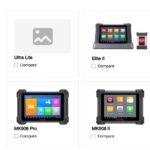VCDS-Lite offers a cost-effective way to diagnose and troubleshoot Audi vehicles in the UK. This article explores using VCDS-Lite software with a third-party USB-to-OBD2 cable, outlining the setup process and potential challenges for Audi owners.
Understanding VCDS-Lite and its Limitations
VCDS-Lite, a free version of the professional VCDS software by Ross-Tech, provides basic diagnostic functionality for VAG (Volkswagen Audi Group) cars. While a valuable tool, VCDS-Lite has limitations compared to the full version. Key differences include the absence of auto-scan, requiring manual module-by-module scanning. Additionally, some fault code descriptions are generic, necessitating online research for detailed explanations. Despite these limitations, VCDS-Lite remains a powerful tool for basic diagnostics.
Selecting a Compatible Cable
Choosing the right cable is crucial for VCDS-Lite compatibility. Many inexpensive USB-to-OBD2 cables are available on online marketplaces like eBay. These cables often utilize the CH340 chipset, as opposed to the FTDI chipset found in official Ross-Tech cables. While typically functional, these budget-friendly options may require additional driver installation and configuration.
Setting Up VCDS-Lite with a CH340 Cable
Setting up VCDS-Lite with a CH340 cable can require a few extra steps:
Driver Installation:
Windows may automatically install a generic CH340 driver, but it’s recommended to download and install the latest driver directly from the chip manufacturer’s website (wch.cn). This ensures optimal performance and compatibility.
COM Port Assignment:
VCDS-Lite requires the cable to be assigned to a COM port within the range of COM1 to COM4. If Windows assigns a higher COM port number, it must be manually reassigned within Device Manager.
VCDS-Lite Configuration:
Within VCDS-Lite options, select the correct COM port and adjust the Start Baud rate to 9600. This setting is often crucial for establishing communication with the engine control unit, preventing “cannot sync baud rate” errors. This baud rate adjustment ensures proper communication with all modules.
Practical Application and Results
After proper setup, VCDS-Lite can successfully read fault codes from various modules, allowing for diagnosis and troubleshooting. For instance, it can identify issues like intermittent door lock malfunctions or communication errors between the engine and A/C controller. While the free version may lack the comprehensive features of the paid version, it still provides valuable insights into the health of your Audi.
Conclusion
Using VCDS-Lite with a budget-friendly cable provides a viable solution for Audi owners in the UK seeking a cost-effective diagnostic tool. While some setup challenges may arise, following the outlined steps allows for successful implementation. While limitations exist, VCDS-Lite remains a valuable tool for basic diagnostics and troubleshooting, empowering Audi owners to understand and address potential vehicle issues.

